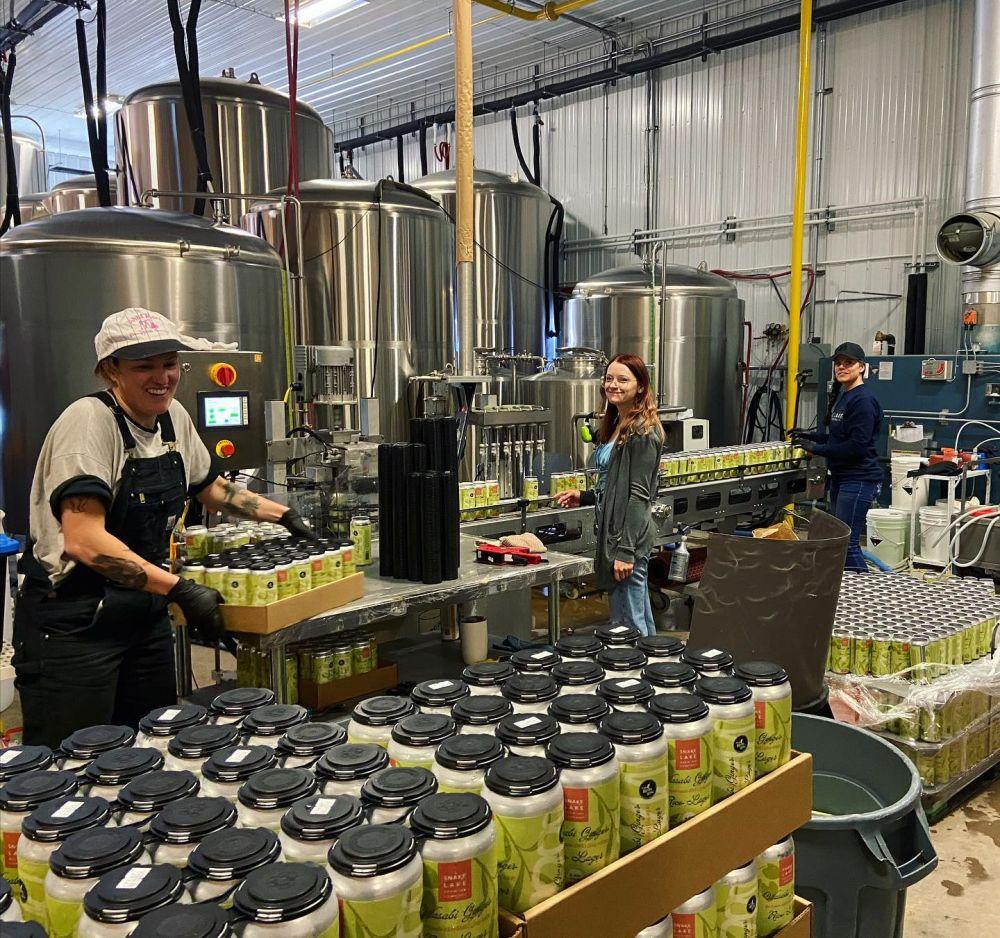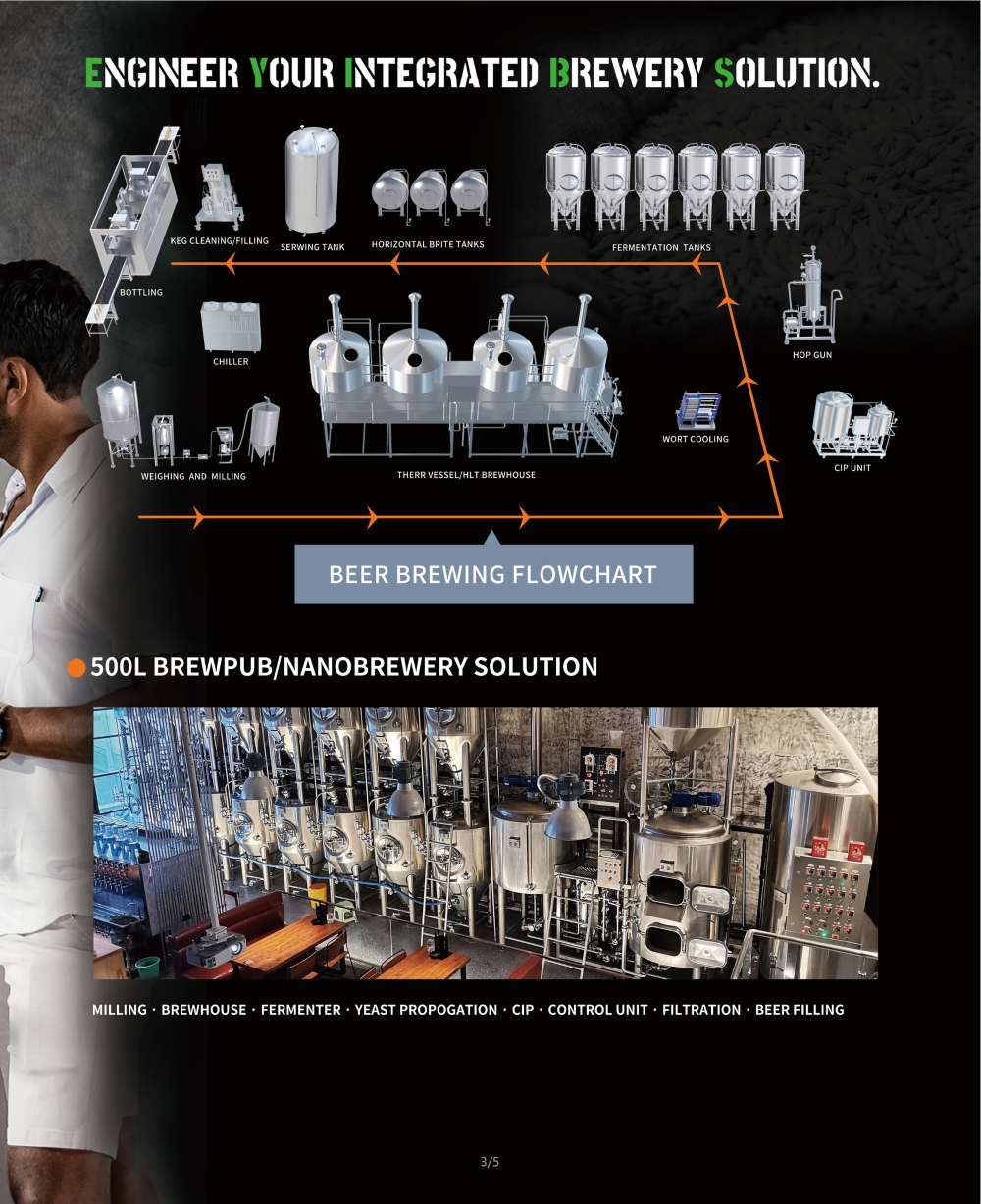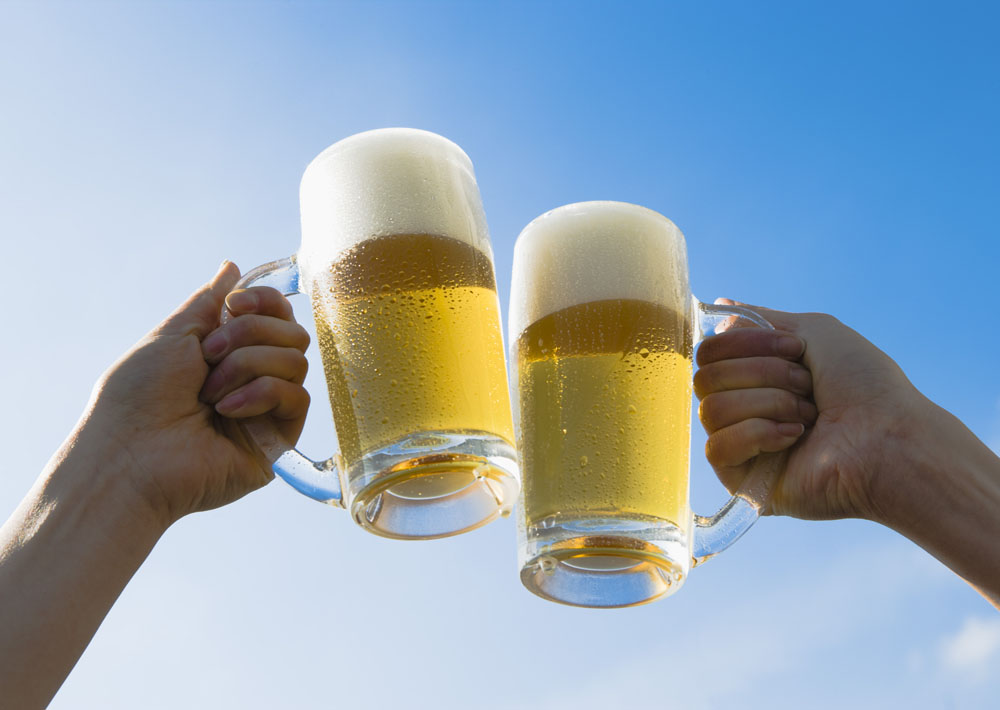The brewing and distilling processes are very similar in their initial steps, so overall breweries and distilleries have a lot in common.
However, they also have significant differences, and understanding these differences is key to optimizing the processes that go into making beer and spirits.
Let’s take a closer look at the differences between a distillery vs. brewery, including the processes behind brewing and distilling, the necessary equipment, and how TIANTAI Beer Equipment can help.
However, they also have significant differences, and understanding these differences is key to optimizing the processes that go into making beer and spirits.
Let’s take a closer look at the differences between a distillery vs. brewery, including the processes behind brewing and distilling, the necessary equipment, and how TIANTAI Beer Equipment can help.
How the Brewing and Distilling Processes Differ?
During the brewing process, malted grains are first crushed to expose the starches. Distilling typically uses unmalted grains.
The crushed grains are mixed with hot water in a process known as mashing. During the mashing process, enzymes from the grain convert the starches to sugar.
The resulting mixture is a sugary liquid of malt and other grains called wort. For beer, hops is typically added at this stage as well, though this is far less common for spirits.
Next, the wort is boiled to sterilize it, then cooled to a workable temperature. The cooled liquid is placed into a fermentation vessel with the brewer’s preferred yeast. The yeast consumes the sugar in the wort, and as a by-product creates the low levels of alcohol common to beer.
Distilling begins with a nearly identical process to brewing. However, distillation goes one step further. After fermenting, the liquid is boiled to extract the alcohol. The steam from the boiling is condensed into a product with a far higher alcohol concentration than the starting liquid–this is how spirits are made.
Another significant difference between a distillery vs. brewery is the grain and grain crushing process. With brewing, a malted barley is used, and the milling step only involves an initial crush. The husk is also kept intact to create a good filter when it’s time to strain the liquid off.
With distilling, typically unmalted corn, rye, wheat, or barley is used, depending on the type of spirit being made. Malted corn or barley can be used for distilling, but this is not as common.
There are also two very different methods of distillation. One is grain-in fermentation, where the grain is milled as finely as possible and then put into the fermenter. The other is grain-out fermentation. There, like in the brewing process, wort is drained (or lautered) from the grains.
Each method of fermentation creates different particle sizes. Grain-in fermentation is used when the entire batch of malt is put into the fermentation process, and grain-out fermentation is used if lautering is planned before fermentation.

The resulting mixture is a sugary liquid of malt and other grains called wort. For beer, hops is typically added at this stage as well, though this is far less common for spirits.
Next, the wort is boiled to sterilize it, then cooled to a workable temperature. The cooled liquid is placed into a fermentation vessel with the brewer’s preferred yeast. The yeast consumes the sugar in the wort, and as a by-product creates the low levels of alcohol common to beer.
Distilling begins with a nearly identical process to brewing. However, distillation goes one step further. After fermenting, the liquid is boiled to extract the alcohol. The steam from the boiling is condensed into a product with a far higher alcohol concentration than the starting liquid–this is how spirits are made.
Another significant difference between a distillery vs. brewery is the grain and grain crushing process. With brewing, a malted barley is used, and the milling step only involves an initial crush. The husk is also kept intact to create a good filter when it’s time to strain the liquid off.
With distilling, typically unmalted corn, rye, wheat, or barley is used, depending on the type of spirit being made. Malted corn or barley can be used for distilling, but this is not as common.
There are also two very different methods of distillation. One is grain-in fermentation, where the grain is milled as finely as possible and then put into the fermenter. The other is grain-out fermentation. There, like in the brewing process, wort is drained (or lautered) from the grains.
Each method of fermentation creates different particle sizes. Grain-in fermentation is used when the entire batch of malt is put into the fermentation process, and grain-out fermentation is used if lautering is planned before fermentation.

What Is the Difference Between the Equipment Needed for a Distillery vs. Brewery?
The equipment needed for a distillery and a brewery shares some similarities, but they serve different processes and goals. Here’s a detailed breakdown:
1. Purpose
Brewery: Focuses on fermenting grains, hops, and water to create beer.
Distillery: Focuses on distilling fermented grains, fruits, or sugar to produce spirits like whiskey, rum, or vodka.
2. Key Equipment
Brewing Equipment (for beer production):
Mash Tun: For mashing grains with hot water to convert starches into sugars.
Lauter Tun: Used to separate the wort (sugar-rich liquid) from the grain husks.
Kettle/Boil Tank: For boiling the wort and adding hops for flavor and aroma.
Fermentors: Tanks where yeast ferments the wort to produce beer.
Bright Tanks: For conditioning, carbonating, and storing beer before packaging.
Kegging/Bottling Equipment: For beer packaging.
Distillation Equipment (for spirits production):
Mash Cooker: Similar to the mash tun in brewing, for cooking the grains or raw materials.
Fermentors: Similar to breweries, for fermenting the mash to produce alcohol (known as "wash" or "beer" in distillation).
Still: The defining equipment of a distillery. Stills (e.g., pot stills or column stills) are used to distill alcohol from the fermented wash.
Condensers: For cooling and condensing vaporized alcohol back into liquid form.
Barrels (for aging): Used for aging spirits like whiskey or rum to develop flavor profiles.
3. Processing Temperatures
Brewery: Operates at lower temperatures during fermentation, typically between 50–70°F (10–21°C), to produce beer.
Distillery: Distillation requires much higher temperatures to vaporize and condense alcohol.
4. Output
Brewery: Produces finished beer that is ready for consumption after fermentation and conditioning.
Distillery: Produces "raw" distilled spirits, which often require aging and additional processing before consumption.
5. Similarities
Both use fermentors for alcohol production.
Grain handling equipment (e.g., mills, conveyors) is often similar.
Cleaning systems (CIP) and pumps are common in both setups.
6. Specialized Needs
Distillery: Needs precision in distillation processes for specific alcohol cuts (heads, hearts, tails) and higher-proof alcohol production.
Brewery: Focuses more on fermentation control, carbonation, and flavoring with hops or additives.
While breweries and distilleries share some overlapping equipment, the addition of distillation equipment like stills and condensers is the key difference for distilleries. Breweries emphasize fermentation and brewing processes, while distilleries focus on both fermentation and distillation to produce spirits.
.jpg)
1. Purpose
Brewery: Focuses on fermenting grains, hops, and water to create beer.
Distillery: Focuses on distilling fermented grains, fruits, or sugar to produce spirits like whiskey, rum, or vodka.
2. Key Equipment
Brewing Equipment (for beer production):
Mash Tun: For mashing grains with hot water to convert starches into sugars.
Lauter Tun: Used to separate the wort (sugar-rich liquid) from the grain husks.
Kettle/Boil Tank: For boiling the wort and adding hops for flavor and aroma.
Fermentors: Tanks where yeast ferments the wort to produce beer.
Bright Tanks: For conditioning, carbonating, and storing beer before packaging.
Kegging/Bottling Equipment: For beer packaging.
Distillation Equipment (for spirits production):
Mash Cooker: Similar to the mash tun in brewing, for cooking the grains or raw materials.
Fermentors: Similar to breweries, for fermenting the mash to produce alcohol (known as "wash" or "beer" in distillation).
Still: The defining equipment of a distillery. Stills (e.g., pot stills or column stills) are used to distill alcohol from the fermented wash.
Condensers: For cooling and condensing vaporized alcohol back into liquid form.
Barrels (for aging): Used for aging spirits like whiskey or rum to develop flavor profiles.
3. Processing Temperatures
Brewery: Operates at lower temperatures during fermentation, typically between 50–70°F (10–21°C), to produce beer.
Distillery: Distillation requires much higher temperatures to vaporize and condense alcohol.
4. Output
Brewery: Produces finished beer that is ready for consumption after fermentation and conditioning.
Distillery: Produces "raw" distilled spirits, which often require aging and additional processing before consumption.
5. Similarities
Both use fermentors for alcohol production.
Grain handling equipment (e.g., mills, conveyors) is often similar.
Cleaning systems (CIP) and pumps are common in both setups.
6. Specialized Needs
Distillery: Needs precision in distillation processes for specific alcohol cuts (heads, hearts, tails) and higher-proof alcohol production.
Brewery: Focuses more on fermentation control, carbonation, and flavoring with hops or additives.
While breweries and distilleries share some overlapping equipment, the addition of distillation equipment like stills and condensers is the key difference for distilleries. Breweries emphasize fermentation and brewing processes, while distilleries focus on both fermentation and distillation to produce spirits.
.jpg)
What Are the Steps in the Brewing Process, and How Is Distilling Different?
If you’ve ever wondered how to make beer, here’s your answer! The first step, even before brewing, is receiving the malted grain. The malting process essentially consists of getting the barley wet and letting it stay wet for long enough that it starts to germinate. Once that is completed, the water is heated, or hot air is added to the barley to stop fermentation. This provides a jumpstart on converting those starches over into sugars.
The next step in brewing is milling the whole grain. This separates the husk from the endosperm, and provides an initial crush. This coarsely crushed malt is then put into the mash tun, where the malt and water are combined. This starts converting the starches into sugars. The temperature that the mash is set at will change the sugar enzymes coming from the malt. After the mash process, the mixture is left to sit for an hour.
The next step is lautering, where the wort is strained from the solids. This involves a process known as sparging, where clean water is added to the mash, and the wort is separated from the grain. From there, the hot, sugary wort is converted over to a kettle and boiled for 60 to 90 minutes. When brewing beer, adding hops in at different points of the boil will give different flavor profiles, and change the bitterness of the beer.
After boiling, whirlpooling is done. The hot wort is either pumped into another vessel called a “whirlpool” or is recirculated into the boil kettle. This separates the solids, and helps extract some of the visual matter from liquids. Then, this hot wort goes to the fermenter, passing through a heat exchanger. The heat exchanger brings the temperature down as quickly as possible to fermentation temperatures so the yeast doesn’t die.
In some instances, that is the final process before bottling. However, depending on the style of the beer, more yeast may be added in the fermenter. In those cases, the yeast feeds on the wort and creates both CO2 and alcohol. Once this is complete, the beer is ready to be packaged in cans, bottles, or kegs. The beer is put into what’s called a bright tank, where it’s going to either be packaged or poured directly into a serving vessel.
Distilling takes things a step further. After fermentation, distillers put the liquid into either a pot still or a column still and it is boiled again. The still recaptures the evaporated alcohol that comes off of that liquid. This alcohol is then condensed and either put into barrels for aging or containers for serving spirits. Here is a video of how to distill vodka to help you learn the distilling process, please check:
The next step in brewing is milling the whole grain. This separates the husk from the endosperm, and provides an initial crush. This coarsely crushed malt is then put into the mash tun, where the malt and water are combined. This starts converting the starches into sugars. The temperature that the mash is set at will change the sugar enzymes coming from the malt. After the mash process, the mixture is left to sit for an hour.
The next step is lautering, where the wort is strained from the solids. This involves a process known as sparging, where clean water is added to the mash, and the wort is separated from the grain. From there, the hot, sugary wort is converted over to a kettle and boiled for 60 to 90 minutes. When brewing beer, adding hops in at different points of the boil will give different flavor profiles, and change the bitterness of the beer.
After boiling, whirlpooling is done. The hot wort is either pumped into another vessel called a “whirlpool” or is recirculated into the boil kettle. This separates the solids, and helps extract some of the visual matter from liquids. Then, this hot wort goes to the fermenter, passing through a heat exchanger. The heat exchanger brings the temperature down as quickly as possible to fermentation temperatures so the yeast doesn’t die.
In some instances, that is the final process before bottling. However, depending on the style of the beer, more yeast may be added in the fermenter. In those cases, the yeast feeds on the wort and creates both CO2 and alcohol. Once this is complete, the beer is ready to be packaged in cans, bottles, or kegs. The beer is put into what’s called a bright tank, where it’s going to either be packaged or poured directly into a serving vessel.
Distilling takes things a step further. After fermentation, distillers put the liquid into either a pot still or a column still and it is boiled again. The still recaptures the evaporated alcohol that comes off of that liquid. This alcohol is then condensed and either put into barrels for aging or containers for serving spirits. Here is a video of how to distill vodka to help you learn the distilling process, please check:
How Can TIANTAI Beer Equipment Help?
The team at TIANTAI Company is experienced in brewing distilling processes and the equipment required for them.
We also have a large network of partners we work with at different levels and aspects of the process.
This allows us to offer comprehensive service for the entire brewing and distilling process.
TIANTAI believes in partnering with customers for long-lasting partnerships. Whether it is providing equipment, giving guidance on what direction makes the most sense, or putting you in contact with experts who can answer industry-specific questions, TIANTAI is here for you.
We’re not just equipment manufacturers trying to sell you a piece of equipment. We are here for continued growth, whether you’re established or just starting out. From a startup brewery to a large distillery looking for an expansion, we have a wide variety of solutions. TIANTAI can help you get going in the right direction, or direct you to someone who can help.
If you’re ready to level up your brewing or distilling process, or if you have questions about brewing and distilling equipment, contact us today.
The team at TIANTAI Company is experienced in brewing distilling processes and the equipment required for them.
We also have a large network of partners we work with at different levels and aspects of the process.
This allows us to offer comprehensive service for the entire brewing and distilling process.
TIANTAI believes in partnering with customers for long-lasting partnerships. Whether it is providing equipment, giving guidance on what direction makes the most sense, or putting you in contact with experts who can answer industry-specific questions, TIANTAI is here for you.
We’re not just equipment manufacturers trying to sell you a piece of equipment. We are here for continued growth, whether you’re established or just starting out. From a startup brewery to a large distillery looking for an expansion, we have a wide variety of solutions. TIANTAI can help you get going in the right direction, or direct you to someone who can help.
If you’re ready to level up your brewing or distilling process, or if you have questions about brewing and distilling equipment, contact us today.
Check Out Our Case Study on Distilling
Interested in learning more about how TIANTAI supports distilleries and breweries? Read about how a historic distillery saw better throughput, more consistent , and a superior yield by optimizing its TIANTAI in our case study

Edited By Daisy
[email protected]

Edited By Daisy
[email protected]



.jpg)
.jpg)
.jpg)

Get In Touch